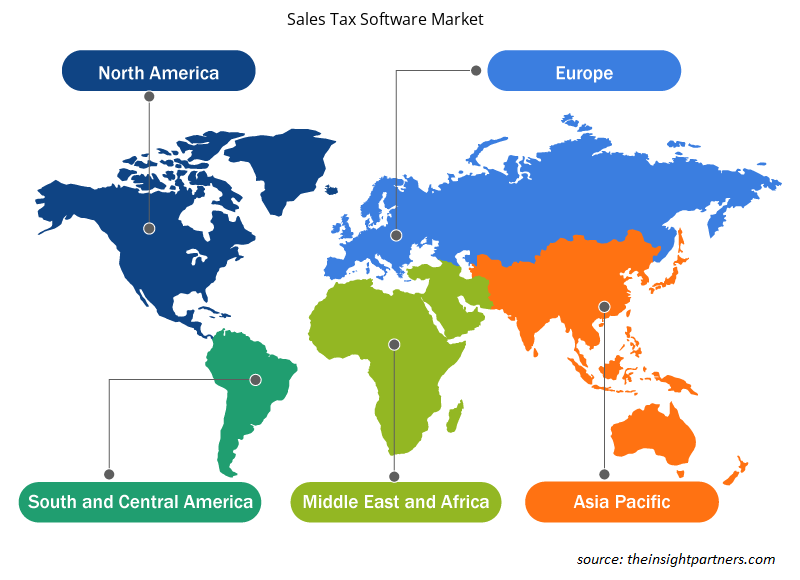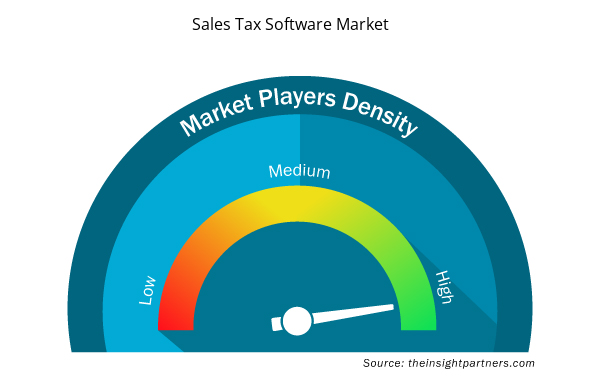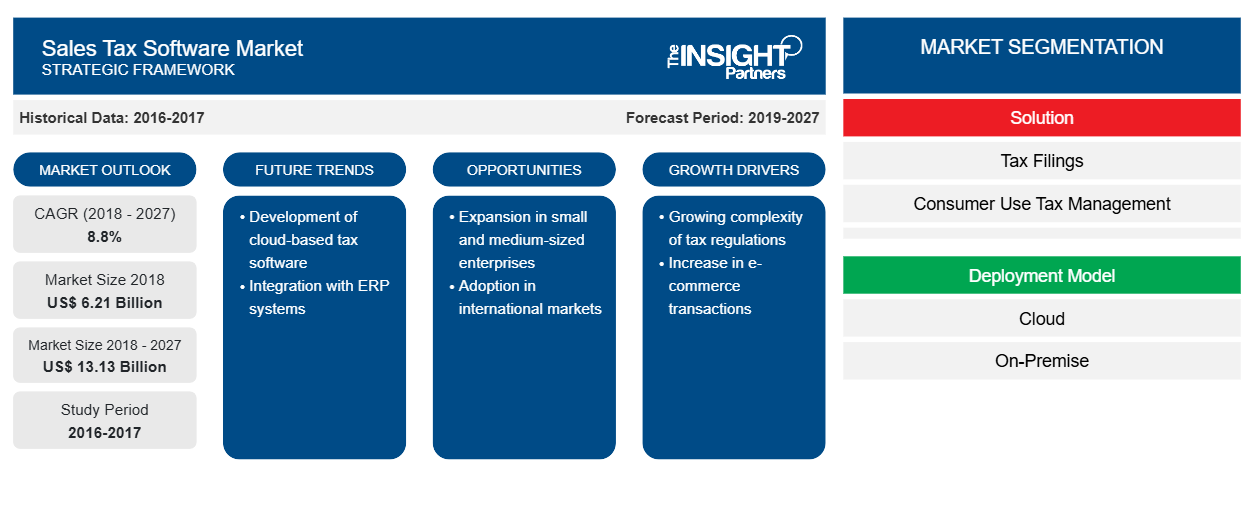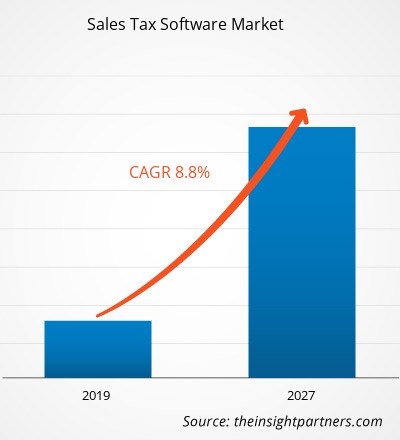[Rapporto di ricerca] Il mercato del software per l'imposta sulle vendite ha rappresentato 6,21 miliardi di dollari nel 2018 e si prevede che crescerà a un CAGR dell'8,8% durante il periodo di previsione 2019-2027, fino a raggiungere 13,13 miliardi di dollari entro il 2027.
Tra le varie regioni geografiche, il Nord America è stato il principale mercato di software per imposte sulle vendite e si prevede che sarà il maggiore contributore di entrate per tutto il periodo di previsione. La crescita e l'adozione nel mercato nordamericano del software per imposte sulle vendite sono guidate principalmente dalla crescente domanda di software per imposte sulle vendite da vari settori come vendita al dettaglio, IT e telecomunicazioni, trasporti e assistenza sanitaria, tra gli altri.
Approfondimenti di mercato
Concentrarsi sull'aggiornamento costante delle leggi e delle normative fiscali in tutto il mondo
L'imposta sulle vendite e le imposte indirette sono le principali fonti di entrate per i governi e leggi fiscali efficienti ed elaborate aiutano le autorità a riscuotere il massimo delle entrate fiscali. Con l'aumento del commercio transfrontaliero e della vendita al dettaglio online in tutto il mondo, insieme alle ultime tendenze come l'e-commerce e la digitalizzazione , le autorità fiscali di tutto il mondo aggiornano costantemente le loro leggi e normative fiscali per coprire questi recenti sviluppi nei mercati globali. L'effetto delle modifiche alle leggi e alle normative fiscali è incerto e dipende da molteplici fattori, quindi le aziende devono investire una quantità sostanziale di risorse per comprendere ed evolvere i loro calcoli di determinazione dell'imposta sulle vendite. Con il coinvolgimento degli esseri umani, c'è un alto rischio di perdere dettagli importanti che potrebbero portare a errori di calcolo e sanzioni da parte delle autorità. Le grandi aziende hanno compreso questa esigenza e stanno investendo nell'automazione della determinazione dell'imposta sulle vendite e nel processo di archiviazione al fine di ridurre le possibilità di errore umano, tuttavia, le piccole e medie imprese sono ancora in fase di adattamento all'idea di automazione e digitalizzazione. Quindi, si prevede che le leggi e le normative fiscali in continuo cambiamento guideranno la futura crescita del mercato del software per l'imposta sulle vendite.
Personalizza questo report in base alle tue esigenze
Riceverai la personalizzazione gratuita di qualsiasi report, comprese parti di questo report, o analisi a livello nazionale, pacchetto dati Excel, oltre a usufruire di grandi offerte e sconti per start-up e università
- Scopri le principali tendenze di mercato in questo rapporto.Questo campione GRATUITO includerà analisi di dati che spaziano dalle tendenze di mercato alle stime e alle previsioni.
L'aumento della digitalizzazione alimenta la crescita complessiva del mercato dei software per l'imposta sulle vendite
Questa rivoluzione della digitalizzazione in tutto il mondo rappresenta un'enorme opportunità per le aziende di utilizzare servizi digitali e automazione per trasformare i propri modelli aziendali e i processi esistenti per aumentare l'efficienza operativa e i ricavi. La trasformazione digitale o digitalizzazione delle aziende è fondamentalmente l'integrazione della tecnologia digitale in vari processi aziendali, attività organizzative e modelli aziendali. L'ottimizzazione dei processi aziendali end-to-end, l'efficienza operativa, la riduzione dei costi e degli errori umani sono alcuni dei principali driver della trasformazione digitale in qualsiasi settore. Il cambiamento di paradigma delle aziende dai processi tradizionali ai processi digitali e automatizzati ha prodotto molteplici vantaggi per le imprese, che vanno dal miglioramento dell'efficienza alla riduzione dei costi e all'aumento delle opportunità di ricavi. Oltre a questo, i progressi tecnologici nel cloud computing e nella tecnologia di archiviazione, la potenza delle piattaforme basate su cloud è aumentata a dismisura nell'ultimo decennio. Ciò ha ulteriormente creato nuove opportunità per le aziende di optare per software di imposta sulle vendite basato su cloud.
Informazioni sui componenti
Il mercato globale del software per l'imposta sulle vendite per componente è stato guidato dal segmento delle soluzioni per la determinazione e l'archiviazione delle imposte. Le soluzioni di gestione dei documenti di conformità hanno detenuto la seconda quota più grande nel mercato del software per l'imposta sulle vendite nel 2018 e si prevede che aumenteranno le loro quote durante il periodo di previsione dal 2019 al 2027.
Informazioni sul tipo di distribuzione
Il mercato globale del software per l'imposta sulle vendite per tipo di distribuzione è stato guidato dal segmento cloud. Le aziende sono più inclini al software per l'imposta sulle vendite basato su cloud, poiché la dichiarazione dei redditi viene automaticamente sottoposta a backup su server sicuri. Il software abilitato al cloud consente alle aziende di espandersi rapidamente senza effettuare investimenti significativi nella propria infrastruttura tecnologica, poiché le tecnologie cloud sono estremamente adattabili ai tassi di cambiamento accelerati. Sono adattabili ad ambienti normativi e di reporting dinamici.
Approfondimenti verticali del settore
Il mercato globale del software per l'imposta sulle vendite è segmentato per settore verticale come BFSI, vendita al dettaglio, IT e telecomunicazioni, trasporti, assistenza sanitaria e altri. Nel 2018, la vendita al dettaglio ha detenuto la quota di fatturato più grande nel mercato globale del software per l'imposta sulle vendite e si prevede che manterrà la sua posizione dominante durante il periodo di previsione dal 2019 al 2027. Gli altri utenti finali del mercato del software per l'imposta sulle vendite includono energia, produzione, istruzione e ospitalità.
Gli attori del mercato presenti nel mercato del software per l'imposta sulle vendite si concentrano principalmente sui miglioramenti dei prodotti mediante l'implementazione di tecnologie avanzate. Firmando partnership, contratti, joint venture, finanziamenti e inaugurando nuovi uffici in tutto il mondo, l'azienda può mantenere il suo marchio a livello globale. Di seguito sono elencati alcuni degli sviluppi recenti nel mercato globale del software per l'imposta sulle vendite:
2019: Sovos Compliance e Tytho hanno firmato un accordo di partnership strategica per rafforzare la posizione nella leadership fiscale e anche per assistere nell'implementazione delle soluzioni Sovos Compliance e promuovere anche il suo prodotto.
2017: TaxJar ha chiuso 60 milioni di $ USA nel round di finanziamento di serie A da Insight Venture Partners. Il finanziamento più recente di 2 milioni di $ USA è stato guidato da Rincon Venture Partners e Daher Capital nel 2014. Il finanziamento consentirebbe all'azienda di concentrarsi sullo sviluppo del prodotto e sulle strategie di sviluppo aziendale.
2018: Ryan ha esteso la portata dell'alleanza con Avalara per fornire servizi di consulenza alle aziende di carburante per motori che desiderano cambiare i sistemi ERP per ottenere una determinazione e una rendicontazione fiscali efficienti.
Approfondimenti regionali sul mercato del software per l'imposta sulle vendite
Le tendenze regionali e i fattori che influenzano il mercato del software per l'imposta sulle vendite durante il periodo di previsione sono stati ampiamente spiegati dagli analisti di Insight Partners. Questa sezione discute anche i segmenti e la geografia del mercato del software per l'imposta sulle vendite in Nord America, Europa, Asia Pacifico, Medio Oriente e Africa e America meridionale e centrale.

- Ottieni i dati specifici regionali per il mercato del software per l'imposta sulle vendite
Ambito del rapporto di mercato del software per l'imposta sulle vendite
| Attributo del report | Dettagli |
|---|---|
| Dimensioni del mercato nel 2018 | 6,21 miliardi di dollari USA |
| Dimensioni del mercato entro il 2027 | 13,13 miliardi di dollari USA |
| CAGR globale (2018 - 2027) | 8,8% |
| Dati storici | 2016-2017 |
| Periodo di previsione | 2019-2027 |
| Segmenti coperti | Per soluzione
|
| Regioni e Paesi coperti | America del Nord
|
| Leader di mercato e profili aziendali chiave |
|
Densità degli attori del mercato: comprendere il suo impatto sulle dinamiche aziendali
Il mercato del software per le imposte sulle vendite sta crescendo rapidamente, spinto dalla crescente domanda degli utenti finali dovuta a fattori quali l'evoluzione delle preferenze dei consumatori, i progressi tecnologici e una maggiore consapevolezza dei vantaggi del prodotto. Con l'aumento della domanda, le aziende stanno ampliando le loro offerte, innovando per soddisfare le esigenze dei consumatori e capitalizzando sulle tendenze emergenti, il che alimenta ulteriormente la crescita del mercato.
La densità degli operatori di mercato si riferisce alla distribuzione di aziende o società che operano in un particolare mercato o settore. Indica quanti concorrenti (operatori di mercato) sono presenti in un dato spazio di mercato in relazione alle sue dimensioni o al valore di mercato totale.
Le principali aziende che operano nel mercato del software per l'imposta sulle vendite sono:
- Analisi Apex
- Avalara, Inc.
- Società
- Il gruppo Sage PLC
- Società di revisione contabile, revisione contabile e revisione contabile di Sovos LLC.
Disclaimer : le aziende elencate sopra non sono classificate secondo un ordine particolare.

- Ottieni una panoramica dei principali attori del mercato dei software per l'imposta sulle vendite
MERCATO SOFTWARE PER L’IMPOSTA SULLE VENDITE GLOBALE – SEGMENTAZIONE DEL MERCATO
Per componente
- Soluzioni per la determinazione e la presentazione delle imposte
- Soluzioni di gestione dei documenti di conformità
- Servizi
Per tipo di distribuzione
- Nuvola
- In sede
Per settore verticale
- BFSI
- IT e telecomunicazioni
- Vedere al dettaglio
- Assistenza sanitaria
- Trasporti
- Altri
Per Geografia
America del Nord
- NOI
- Canada
- Messico
Europa
- Francia
- Germania
- Regno Unito
- Russia
- Italia
- Resto d'Europa
Asia Pacifico (APAC)
- Corea del Sud
- Cina
- India
- Giappone
- Australia
- Resto dell'APAC
Medio Oriente e Africa (MEA)
- Arabia Saudita
- Sudafrica
- Emirati Arabi Uniti
- Resto del MEA
America del Sud (SAM)
- Brasile
- Argentina
- Resto del SAM
Profili aziendali
- Analisi APEX
- Avalara, Inc.
- Società
- Il gruppo Sage Plc
- Conformità Sovos LLC
- Barattolo delle tasse
- Società Thomson Reuters
- Vertex, Inc.
- Wolters Kluwer (CCH Incorporated)
- Xero limitata
- Analisi storica (2 anni), anno base, previsione (7 anni) con CAGR
- Analisi PEST e SWOT
- Valore/volume delle dimensioni del mercato - Globale, regionale, nazionale
- Industria e panorama competitivo
- Set di dati Excel


- Skin Tightening Market
- Sandwich Panel Market
- Fishing Equipment Market
- Portable Power Station Market
- Mesotherapy Market
- Social Employee Recognition System Market
- Mobile Phone Insurance Market
- 3D Audio Market
- Quantitative Structure-Activity Relationship (QSAR) Market
- Health Economics and Outcome Research (HEOR) Services Market

Report Coverage
Revenue forecast, Company Analysis, Industry landscape, Growth factors, and Trends

Segment Covered
This text is related
to segments covered.

Regional Scope
North America, Europe, Asia Pacific, Middle East & Africa, South & Central America

Country Scope
This text is related
to country scope.
Trends and growth analysis reports related to Technology, Media and Telecommunications : READ MORE..
The List of Companies - Sales Tax Software Market
- Apex Analytix
- Avalara, Inc.
- Ryan, LLC
- The Sage Group PLC
- Sovos Compliance LLC.
- Taxjar
- Thomson Reuters Corporation
- Vertex, Inc.
- Wolters Kluwer (CCH Incorporated)
- Xero Limited
The Insight Partners performs research in 4 major stages: Data Collection & Secondary Research, Primary Research, Data Analysis and Data Triangulation & Final Review.
- Data Collection and Secondary Research:
As a market research and consulting firm operating from a decade, we have published and advised several client across the globe. First step for any study will start with an assessment of currently available data and insights from existing reports. Further, historical and current market information is collected from Investor Presentations, Annual Reports, SEC Filings, etc., and other information related to company’s performance and market positioning are gathered from Paid Databases (Factiva, Hoovers, and Reuters) and various other publications available in public domain.
Several associations trade associates, technical forums, institutes, societies and organization are accessed to gain technical as well as market related insights through their publications such as research papers, blogs and press releases related to the studies are referred to get cues about the market. Further, white papers, journals, magazines, and other news articles published in last 3 years are scrutinized and analyzed to understand the current market trends.
- Primary Research:
The primarily interview analysis comprise of data obtained from industry participants interview and answers to survey questions gathered by in-house primary team.
For primary research, interviews are conducted with industry experts/CEOs/Marketing Managers/VPs/Subject Matter Experts from both demand and supply side to get a 360-degree view of the market. The primary team conducts several interviews based on the complexity of the markets to understand the various market trends and dynamics which makes research more credible and precise.
A typical research interview fulfils the following functions:
- Provides first-hand information on the market size, market trends, growth trends, competitive landscape, and outlook
- Validates and strengthens in-house secondary research findings
- Develops the analysis team’s expertise and market understanding
Primary research involves email interactions and telephone interviews for each market, category, segment, and sub-segment across geographies. The participants who typically take part in such a process include, but are not limited to:
- Industry participants: VPs, business development managers, market intelligence managers and national sales managers
- Outside experts: Valuation experts, research analysts and key opinion leaders specializing in the electronics and semiconductor industry.
Below is the breakup of our primary respondents by company, designation, and region:

Once we receive the confirmation from primary research sources or primary respondents, we finalize the base year market estimation and forecast the data as per the macroeconomic and microeconomic factors assessed during data collection.
- Data Analysis:
Once data is validated through both secondary as well as primary respondents, we finalize the market estimations by hypothesis formulation and factor analysis at regional and country level.
- Macro-Economic Factor Analysis:
We analyse macroeconomic indicators such the gross domestic product (GDP), increase in the demand for goods and services across industries, technological advancement, regional economic growth, governmental policies, the influence of COVID-19, PEST analysis, and other aspects. This analysis aids in setting benchmarks for various nations/regions and approximating market splits. Additionally, the general trend of the aforementioned components aid in determining the market's development possibilities.
- Country Level Data:
Various factors that are especially aligned to the country are taken into account to determine the market size for a certain area and country, including the presence of vendors, such as headquarters and offices, the country's GDP, demand patterns, and industry growth. To comprehend the market dynamics for the nation, a number of growth variables, inhibitors, application areas, and current market trends are researched. The aforementioned elements aid in determining the country's overall market's growth potential.
- Company Profile:
The “Table of Contents” is formulated by listing and analyzing more than 25 - 30 companies operating in the market ecosystem across geographies. However, we profile only 10 companies as a standard practice in our syndicate reports. These 10 companies comprise leading, emerging, and regional players. Nonetheless, our analysis is not restricted to the 10 listed companies, we also analyze other companies present in the market to develop a holistic view and understand the prevailing trends. The “Company Profiles” section in the report covers key facts, business description, products & services, financial information, SWOT analysis, and key developments. The financial information presented is extracted from the annual reports and official documents of the publicly listed companies. Upon collecting the information for the sections of respective companies, we verify them via various primary sources and then compile the data in respective company profiles. The company level information helps us in deriving the base number as well as in forecasting the market size.
- Developing Base Number:
Aggregation of sales statistics (2020-2022) and macro-economic factor, and other secondary and primary research insights are utilized to arrive at base number and related market shares for 2022. The data gaps are identified in this step and relevant market data is analyzed, collected from paid primary interviews or databases. On finalizing the base year market size, forecasts are developed on the basis of macro-economic, industry and market growth factors and company level analysis.
- Data Triangulation and Final Review:
The market findings and base year market size calculations are validated from supply as well as demand side. Demand side validations are based on macro-economic factor analysis and benchmarks for respective regions and countries. In case of supply side validations, revenues of major companies are estimated (in case not available) based on industry benchmark, approximate number of employees, product portfolio, and primary interviews revenues are gathered. Further revenue from target product/service segment is assessed to avoid overshooting of market statistics. In case of heavy deviations between supply and demand side values, all thes steps are repeated to achieve synchronization.
We follow an iterative model, wherein we share our research findings with Subject Matter Experts (SME’s) and Key Opinion Leaders (KOLs) until consensus view of the market is not formulated – this model negates any drastic deviation in the opinions of experts. Only validated and universally acceptable research findings are quoted in our reports.
We have important check points that we use to validate our research findings – which we call – data triangulation, where we validate the information, we generate from secondary sources with primary interviews and then we re-validate with our internal data bases and Subject matter experts. This comprehensive model enables us to deliver high quality, reliable data in shortest possible time.


 Ottieni un campione gratuito per questo repot
Ottieni un campione gratuito per questo repot